Past National Commodores (NACOs) 1970 to 1951
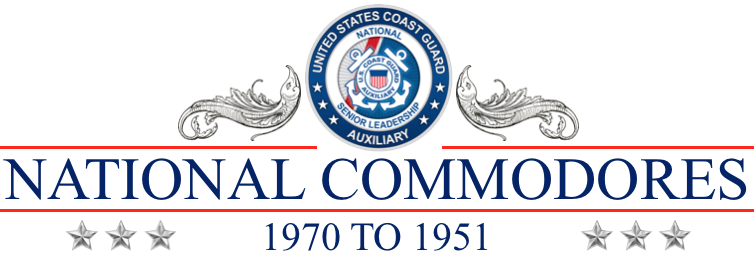
| Galleries | 2024-2011 | 2010-1991 | 1990-1971 | 1970-1951 |
![]()
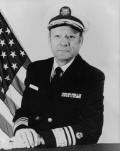 |
PNACO John B. Stone 1969-1970 Deceased |
John B. Stone was elected national commodore at the annual meeting of the National Board on September 20, 21, 1968, to serve from 1969 through 1970. Hailing from Los Angeles, Stone was elected while serving as Immediate Past Commodore of the 11th Coast Guard District.
Under Stone's leadership, the U. S. Naval Institute published AUXOP Specialty Course guides, among them Patrols, Weather, and Piloting. A new Boating Safety and Seamanship course was also initiated (available in the spring of 1971); as was a new sail course. The Membership Growth Program got underway. Also during his term, the Auxiliary worked with Sears Roebuck Company in issuing a Hunter-Fisherman catalogue that contained an Auxiliary insert (hunters and fisherman, historically, have comprised a high percentage of drowning deaths while boating). At the end of his term, Stone was pleased to note the increased interest in the Auxiliary produced by the Public Affairs Department, as well as the increased efforts of women members as reported by the Women's Advisory Committee.
![]()
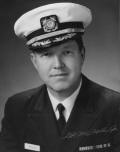 |
PNACO Grover A. Miller, Jr. 1967-1968 Deceased |
Grover A. Miller was born in 1923, to a navy commander and his wife when they were posted to Manila, the Philippines. As a youth, growing up in the islands, Miller began to pilot a motor whaleboat at age six. Eventually he acquired a small fleet that included a 21-foot cabin cruiser he built himself and a 36-foot Chris Craft. Miller earned a degree in industrial design from Stanford University and he and his family resided in San Francisco, where he headed a large Oldsmobile-Cadillac dealership and a leasing corporation.
Miller enrolled in the Auxiliary in 1955, after he and his wife, Susan, took a PE course. He earned instructor, examiner, communications, and operations qualifications. He served in almost every office and became one of the youngest national commodores at age forty-four.
In the 1960s, Miller became chief of staff to Ellsworth Weinberg. Weinberg and he reorganized the national staff and improved the Auxiliary's image. Miller designed the present Auxiliary ensign with a white slash, which replaced the insignia on a navy background. The previous ensign too much resembled yacht club and other boat flags. Burgees for officers were also introduced. During Miller's tenure the "stars and bars" cuff insignia were replaced with the current Coast Guard silver stripe/collar insignia set. A new uniform system was also introduced. These dress standards held until 1975 when the current uniforms came into use.
During the 1970s Miller went into his own business, inventing and marketing new tools and other developments. In his last years he suffered from cancer. Miller passed away on October 22, 1996, in Sacramento, California. He was survived by one daughter and two sons, of his original five children.
![]()
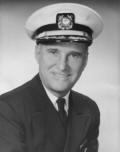 |
PNACO Elsworth A. Weinberg 1964-1965 Deceased |
Ellsworth Weinberg came from the legal profession and first joined the Auxiliary in 1957. He was born in West Virginia and received degrees from the University of Baltimore and Southern Methodist University. In Dallas where he died on December 7, 1986, he was a nationally known attorney. Weinberg quickly rose through the ranks of Auxiliary offices, holding virtually every one, including numerous staff officer positions. He earned his AUXOP designation the same year he joined. He was elected national commodore in 1965. After two terms, he served as legal officer for the 8th CG District and as National Legal officer, holding that position until he died. For the 50th Anniversary of the Auxiliary he also published The Volunteers a short history of the Coast Guard Auxiliary during World War II.
In 1984, Weinberg received the "C" award of Administrative Merit and was awarded the Michelob Schooner boating award at the eastern area conference in 1986. He had also been a member of the U. S. Power Squadron. During World War II, Weinberg had served four years in the South West Pacific Theater in the U. S. Navy.
He was survived by his wife, Caroline, at the time of his death.
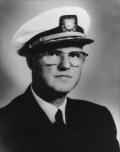 |
PNACO Homer L. Byers 1962-1963 Deceased |
Homer L. Byers outlined the accomplishments of the Auxiliary during the previous five years in his opening message to members, published in the September 1962 issue of the Navigator. There had been: 1) a 50 percent increase in membership, along with a clearing out of "deadwood" members; 2) PE students had tripled; 3) CMEs had increased 500%. "During 1957, Auxiliarists were instrumental in saving 42 lives; in 1961 there were 200 lives saved." He noted that in spite of this excellent record, the Auxiliary was only touching a small portion of the 35-40 million Americans who were participating in boating. Later he would note that Auxiliary units operated in every major boating area in the country.
In this and future messages, Byers stated that the Auxiliary was "big business" and the leadership must think big in terms of long range planning, setting large goals, even suggesting the organization realize a membership of 100,000. But big goals can only be accomplished through: planning, organizing, and controlling. The vast expansion of the early '60s was going to require that the Auxiliary take charge of more of its own functions. As part of this administrative expansion in 1964, the National Board voted to increase the number of national staff officers from six to eight. The Auxiliary also adopted "parallel staffing" to align unit functions with those of the Coast Guard to ensure improved communications and organizational integrity.
But Byers was not just a dreamer. He set down practical targets. In February 1963, he called on each flotilla to recruit, on average, 200 students to their courses, which would bring total enrollment nationwide to more than 150,000. In carrying out plans, Byers emphasized the need for planning, follow through, and balanced programs. The National Staff exists to support the Districts in their functions. For instance the national Public Instruction officer, along with his committee, would advise on: course materials to be used and techniques to be employed; how to set up TV programs for public instruction; and on member training. Equal weight should be given to PE and MT.
Regarding vessel examinations, Byers's goal was to see that every member became qualified, as the need was so great. States had taken over boat numbering registration, so it became important for CME officers to liaise with state representatives.
Describing operations as "still in its infancy, but growing fast," Byers recognized its potential by appointing the first national operations officer. He established separate committees that were responsible for: surface, air, and radio communications. These three branch programs would be integrated and coordinated on a national basis, also for the first time. A member operational guide was promulgated, with an accompanying requirement that trainees demonstrate abilities in personnel retrieval and towing. He noted that in July 1963, 155 lives had been saved to date in that year, but wondered if the crews had been sufficiently recognized. Every member's talents and skills must be optimally employed and rewarded.
Finally, Byers emphasized the importance of the fourth Auxiliary cornerstone: fellowship. He suggested that Auxiliarists be more inclusive and broaden their "boating brotherhood" beyond small circles of friends. The newly elected NAVCO Charles Levitan advocated the development of a speakers' bureau to publicize the Auxiliary. Promotion of Auxiliary programs, particularly National Safe Boating Week, through liaison with other boating groups and government agencies was stressed. As an example at the 1962 national conference, the Federal Communications Commission's chief engineer noted the Auxiliary's role in advising the public about its requirements through its public education program.
During Byers's tenure, Auxiliary membership and programs continued to grow at a rapid pace, ultimately reaching a membership of 30,000 and 16,000 surface facilities in 1970, 50- and 30% increases, respectively, from 1960.
From reading his exhortations to members, it's clear that Homer Byers had a strong sense of purpose that likely resulted from his Midwest upbringing in Anderson, Indiana and his personnel business background. His traits also clearly played a role for in his NAVCO biography he was described as "a tall, slim, energetic fellow, well indoctrinated in Auxiliary purposes."
Byers was born in Moundsville, West Virginia in 1903. At age eighteen he moved to New York City from Indiana and five years later to San Francisco. In 1948 he relocated to Palo Alto where he resided permanently with his wife, Virginia, and two children. At the time of his election as NACO, Byers held the professional position of Administration Personnel Supervisor in the General Administration Office of the Pacific Telephone Company. Boating was the main recreation of the family; hobbies included rock collecting, geology, camping, and fishing.
As Byers rose through the ranks of the Auxiliary from District Commodore of the 12th, to NAVCO in Woodward's second year, to NACO, he found he had less and less time to devote to operations or family cruises. In acknowledging remarks following his election as NAVCO, Byers thanked the Board. He felt very honored and would serve as best he could. This honor, however, was tempered by a dose of regret, "When I first was elected a District Commodore I discovered that I couldn't use my boat very much. I should have been told to put it on the beach for the duration. I don't know what I will have to give up for the coming year, but it will be done gladly as I give my allegiance to all the Districts. I will have to think on broader terms. I will be gaining many new friends and meeting what I think are the nicest people you can find anywhere, the Auxiliarists."
Presently there is no known date of death for Byers.
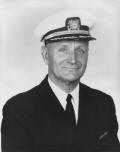 |
PNACO Bliss Woodward 1960-1961 Deceased |
Bliss Woodward entered office as a 20-year Auxiliary member and past commodore of the 3rd District, having been first elected to that office in 1955. He was active in Long Island boating circles out of Mamaroneck, an example being his participation in the 1959 predicted log-cruise navigation test race. His vessel was named Hel 'N Bliss, for him and his wife. The N.Y.-N.J.-L.I.-Ct. region was one of the most important boating areas in the nation with more than 62,000 registered motor boats and the second largest Auxiliary membership of 1,736. Like other Districts, members greatly increased their activities during the 1950s. In the 3rd, CMEs had increased from 2,806 in 1951 to 5,028 in 1954, the year before Woodward was elected DCO. When CMEs were first extended to outboard-engined cabin cruisers in 1955, Woodward and DIRAUX Capt. Lloyd Albin, USCG, were featured in a New York Times photograph overseeing the examination of a 21-foot Olympia, powered by a 25 hp Evinrude outboard engine.
As NAVCO to Charles Greanoff, Woodward managed the 1959 National Safe Boating Week activities. He put together a coalition of boating, safety, and youth organizations, including the Power Squadron, the Outboard Boating Club of America, the Red Cross, marine dealers, and the Boy Scouts, among others, which staged events across the nation. In Atlanta members featured safe boating films at local theaters; St. Louis organizations embarked on a 200-boat parade. At the time NSBW was only a year old, having been first proclaimed by Pres. Dwight D. Eisenhower in 1958.
Woodward held the office of NACO at a time when the Auxiliary was expanding exponentially and fast becoming a powerful national organization. Although boating had grown considerably during the postwar era, boosts were given during the 1960s by: the introduction of inexpensive fiberglass boats; the addition of thousands of miles of waterways through the construction of hundreds of federal reservoir and dam lakes, especially in the West; the postwar migration to California and Florida by new residents and tourists.
By 1960, Auxiliary membership had grown from about 13,000 during the '50s to nearly 20,000 in 1960. The number of facilities grew by an estimated 400 per year. Yet patrols increased from 840 in 1960 to an estimated 10,000 over the next five years.
During his tenure Woodward expanded on the previous work of John Tanner and Charles Greanoff, supporting cornerstone missions, as well as new programs such as the "Academy Activity Week" (later formalized as the Academy Introduction Program or AIM); and National Safe Boating Week. His national staff comprised: a National Educational Research Officer, National Secretary-Treasurer, National Publications Officer, and National Public Instruction Officer. In January 1962, at the beginning of his second year in office, Woodward complimented members on their accomplishments of the previous year, but urged them to "redouble" their efforts. Woodward particularly stressed the need for Districts to expand their public education programs, the March 1962 Navigator advising:
. . . .we find that many Districts participate only nominally in this phase of Auxiliary activity. Many Divisions have overlooked this program to the point that no public instruction courses are offered, and of the entire membership, not one member has been certified as an instructor. An examination of our public instruction effort reveals that one District has contributed approximately 50% of the national effort in this field. In fact, we have the anomaly on one Division in this District doing more than entire Districts.
The editorial went on to encourage every member to participate in public education and every District to surpass the performance of the current lead one. Due to this emphasis the attendance in PE classes more than doubled by the fall of 1962. Woodward and team had also gotten the boating safety course recognized at six state universities.
As a corollary the Auxiliary issued revised instruction manuals: the "Basic Seamanship Course" booklet doubled in length and accompanying 35 mm slides were made available; the "Practical Course on Outboard Handling," was expanded by one-third and included colored diagrams and charts. The first aid manual recommended by the Educational Research Committee in 1960 was published in 1962; leaders hoped it could be used as a standard reference by boaters and a training aid for members.
A revised, expanded Vessel Examination manual (CG-289) was issued that outlined a 5-lesson training course for examiners. In 1961, 750,000 "Seal of Safety" booklets were distributed that described CME requirements. Woodward and the Board also moved to improve and standardize the Auxiliary communications program due to a number of factors. Boaters were utilizing both Citizen Band (C. B.) and VHF radios and Auxiliary ham radio operators wanted to be folded into the communications network. Patrol reports had found that during the previous season "the Auxiliary made better use of their radio equipped facilities during the various patrols. . . ," suggesting it would pay to have technical training for crews. These circumstances led the National Board to establish a National Communications Committee. Its goals were: to develop a national communications program, along with proper training; set minimum standards of quality and reliability for radio facilities; make better use of ham radio facilities and inform members how to properly train in use of C. B. and VHF radios, and employ the latter (C. B. radios were not advised for Auxiliary use).
Perhaps Woodward's most outstanding single achievement was the first publication of the Auxiliary's national magazine, the Navigator that commenced in 1961. Previously Auxiliary columns had been run in national boating magazines, but no member publication was available. The first issues featured the Auxiliary emblem on a Navy background in the top section of the front page with the title in white lettering. The bottom part contained a cover photo on a white background. Initially issues were less than ten pages in length.
During 1960-62, the Auxiliary also moved to create alliances with other boating and federal organizations. Woodward appointed a national liaison to the U. S. Power Squadron in 1961. The Auxiliary was apprised of the work of "Advisory Panel of State Officials of the Merchant Marine Council, U. S. Coast Guard," in standardizing the waterways marking system of the United States. In 1962, the Auxiliary signed an agreement with the National Coast and Geodetic Survey and National Ocean Service to assist in chart updating, a program that continues to this day.
Also in 1962, the Commandant gave his approval to an official Auxiliary song composed by Division captain, J. J. Drexler of the Third District. An Auxiliary ring design was also approved by the National Board. 1n 1962, the National Board proclaimed June 23, "Coast Guard Auxiliary Day." Woodward began the tradition of employing celebrities to help publicize the Auxiliary, having appointed the television star Preston Foster, an honorary commodore.
For his "conscientious work and outstanding leadership" as evidenced by the "smooth functioning and noteworthy accomplishments" during his period in office, NACO Woodward was awarded the Certificate of Merit (B) Award by Vice Adm. E. J. Roland, acting commandant. At the end of his term, Woodward specifically noted how valuable his experience as a national staff member had been and vowed to continue his activities in the Auxiliary. In 1968, Woodward served on Mamaroneck, New York's safe harbor committee formed to serve the needs of the community's growing boater population. In 1969, the commandant appointed him to the Coast Guard's Merchant Marine Council.
Bliss Woodward was able to garner considerable publicity for the Auxiliary and himself as District and National Commodore, not only because Auxiliary member Charles Grutzner was a New York Times reporter, but because of the Woodward family's prominence in New York City affairs. His father Arthur Woodward, was originally from St. Louis, but moved to New York where he owned a printing plant that later became A. W. Advertising. His mother, Alma Newman Woodward, was the company's treasurer and headed the copy department for many years. Later she started her own company, Alma Woodward Products, and was a feature writer for the New York Evening World.
During the 1920s and early 1930s, the Woodwards participated in the social whirl of New York's upper crust, associating with the Whitneys, Goulds, Fahnestocks*, and Joneses. Social column notices feature Bliss as a gay blade, performing and assisting at charity and debutante events organized by the youth set. In 1928, Woodward married Emmie Lou Sperry whose father owned Sperry-Hutchinson, the (S&H) green stamp retailing company.
The stock market crash and Depression, however, devastated the family. Bliss himself filed for bankruptcy in 1932. Two years later, his father suffered a stroke, and although suicide was not hinted in the press, one morning he fell or jumped out of the twelfth floor window of the Beverly Hotel where the family resided. By 1935, Bliss Woodward had become president of the advertising firm and married a second time to Helen Marshall of Joplin, Missouri, a graduate of Julliard School of Music and a violin soloist. In 1955, he was named vice president of Waters and Associates, another advertising company.
Given the family's social prominence, most likely Woodward came out of Mamaroneck yachting clubs during the 1930s and may have been a charter Auxiliary member. There are presently no known dates of birth or death.
* J. Sheridan and A. Bruce Fahnestock were the two Long Island brothers who enrolled Gen. Douglas MacArthur's small boats and crews that served in New Guinea and the Philippines during World War II; many Auxiliarists signed on as civilian army contract employees with the Army's Transportation Service, Small Ships Branch. See "MacArthur's Navy" in text articles. The family owned a New York City investment company that still exists and were personal friends of Pres. Franklin D. Roosevelt.
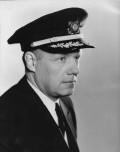 |
PNACO Charles S. Greanoff 1958-1959 Deceased |
Charles S. Greanoff was one of the persons most responsible for turning the Auxiliary into the professional organization it is today. As National Commodore, Greanoff traveled the country to support the cornerstone missions of the Auxiliary. He oversaw the activities of the first National Safe Boating Week in 1958; he put the Academy Introduction Mission (AIM) program on a stronger footing; and testifying at hearings held for the 1958 Federal Boating Act, he helped persuade the Congress to leave boat registration to the states. During his two terms of service he incorporated the national board and raised the Auxiliary's level of professionalism.
During the next five decades, COMO Greanoff continued to accrue thousands of hours of support each year for all the Coast Guard's missions. As of 1995, he was still active as a qualified communications watchstander and worked at the 9th District Auxiliary Director's office. And then he began his third Coast Guard career.
In 1991, Greanoff was appointed assistant to the Ninth CG District Family Programs Administrator. He was a key player in the establishment of the fledgling Work Life program developed in D9. In March 1993 COMO Greanoff was appointed the Ninth District Ombudsman Coordinator, the first Ombudsman Coordinator position created in the Coast Guard, working in that capacity until 2005. In this role, Greanoff trained more than 150 district Ombudsmen at over fifty units around the Great Lakes, providing guidance, training and support to these important volunteers. An Ombudsman is a volunteer (who may be a spouse, Reservist, or Auxiliarist) designated by a Command to serve as a link between the command and service members' families. His/her main responsibilities are to provide information on policies, services and sources of assistance, and activities of interest to family members, as well as locating resources for them. Greanoff held this position until 2005.
In recognition of his consummate leadership and contributions to the Coast Guard and the Auxiliary, in 2006, the Coast Guard created the COMO Charles S. Greanoff Inspirational Leadership Award to be presented annually to the most distinguished flotilla commander in the nation. The first award was presented on April 17, 2006 in Washington, D.C., with Greanoff's son, Charles II, representing his father. "Commodore Greanoff exemplified the Coast Guard ethos of service and volunteerism," said Rear Adm. John E. Crowley, Jr., Commander of the Ninth Coast Guard District. "He contributed immensely to the future of the Coast Guard Auxiliary by selflessly training and mentoring others who carry out their missions today. The Greanoff Inspirational Leadership Award will ensure his legacy will continue to impact our organization for years to come."
Charles S. Greanoff was born in Cleveland, Ohio on May 15, 1915. He graduated from Lakewood High School in 1933 and earned a B. A. degree in history from Baldwin Wallace College in 1936. Greanoff spent his professional life in finance and business. He worked as an accountant for the major consulting firms, Ernst & Ernst and Arthur Young, and was executive vice-president of Gilmore Industries in the 1960s. He owned his own accounting firm, Greanoff & Company, until his death.
At the outset of World War II Greanoff enlisted in the Army, but in 1943 after his brother was killed, he was discharged under the provisions of the 'sole survivor' policy that allowed an only remaining son in a family to be released from combat duty.* In response, Greanoff immediately enrolled in the Coast Guard as a temporary reservist, joining Flotilla 7-03, a port security unit at Cleveland, guarding their waterside factories, bridges, docks, and shipping on the Great Lakes and Cuyahoga River. His routine during the war was to work his day job at the Ohio Crankshaft Company from 8 A.M. until 4 P.M., and then at his flotilla from 8 P.M. until 1 or 2 A.M. in the morning. (TRs were normally required to be on duty twenty-four hours a week during the war.)
At the end of the war in 1945, Charles Greanoff married the former Virginia Taylor who passed away in 1993. They raised a family of four: two daughters and one son, remaining in his hometown of Lakewood, Ohio. During the postwar period Greanoff became an active member in a newly established flotilla that consisted of many previous TRs. He was elected Flotilla Commander in 1950 and quickly rose through the ranks, holding the position of Division Captain in 1953, then Ninth District Commodore in 1956-57. During the 1950s operations activity was limited, but Greanoff's experience conducting search and rescue and attending joint training exercises convinced him that Auxiliary programs had to be active to have a healthy organization. His flotilla, early on, adopted the new courtesy marine examination program. When elected district commodore, Greanoff commissioned new flotillas and standardized programs in the Ninth CG District.
Aside from his family, own business, and the Auxiliary Greanoff was also very active in his college alumni association, serving as its president in during the 1960s. He was admitted into the Baldwin Wallace College Hall of Fame.
On April 3, 2007, COMO Greanoff passed away in Lakewood, Ohio, after a 63-year Auxiliary career.
[* In November 1942, the five sons "Albert, Francis, George, Joseph and Madison" of Mr. and Mrs. Thomas F. Sullivan of Waterloo, Iowa, were killed in action when their ship, the USS Juneau, was torpedoed off Guadalcanal Island. To this date, these deaths represent the largest known loss of life of service members in one American family in U.S. history. In response, the US Army, and later the Navy, issued "sole survivor" policies that allowed surviving sons and daughters to be released from military service, under varying terms over time, to this day.]
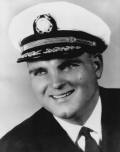 |
PNACO John Brent Tanner 1956-1957 Deceased |
John Brent Henshaw Tanner was one of the most colorful and the youngest of the past national commodores. He had a meteoric rise through the ranks of the Auxiliary. The first office he held was operations officer of Flotilla 14 in San Diego after three years membership, in 1951. He was elected Flotilla Commander the next year and Division Captain in 1953. He served as District Commodore of 11SR from 1955 and resigned during his second term to assume the position of National Commodore at age thirty-six.
Tanner was active in operations on his 36-foot custom marlin sport fisherman "Twin B." He next bought a retired Coast Guard 83-footer on which he conducted fishing cruises with family and friends. Locally he served as the treasurer of the Southwestern Yacht Club of San Diego and into the 1990s continued fishing, his favorite past time.
During Tanner's years as National Commodore, the Auxiliary operations program expanded greatly, due to a number of social and economic factors: the growth of suburbs and boating in the West; pent up postwar consumer demand; the increased affluence of World War II veterans; the baby/teenager boom; the popularity of water skiing. For example between 1954 and '55, the number of regatta patrols increased 35 percent to 314. To meet the needs of the growing boating community, under Tanner's leadership, the 8-lesson boating safety course was revised and new 3- and 1-lesson specialized courses grew in attendance. As part of the national expansion of public education, a National Auxiliary Training Corporation was established to receive fees and text revenues from boating safety courses. Alaska was reactivated as a district.
In July 1956, the U. S. House of Representatives Committee on Merchant Marine and Fisheries, headed by Rep. Herbert C. Bonner of North Carolina, undertook a comprehensive study of the state of boating in the country and the laws that regulated it. During their six months of hearings conducted in the Great Lakes region and on both coasts and the Mississippi River, the Committee found that current laws were inadequate to cut down on the 285 deaths and 640 casualties of the previous year. For instance if a Coast Guard boat crew were to witness a small overloaded vessel going out in bad weather with an inebriated skipper, the officer in charge had no legal authority to halt its operation, except to warn of dangers.
During the course of the hearings the congressmen heard from among others, Coast Guard personnel, yacht club members, boating magazine editors, and fifteen member of the Auxiliary who included NACO John B. Tanner.
Tanner briefed the committee on the Courtesy Marine Examination program, advising that in 1955, Auxiliary examiners had check-listed 28, 417 boats, of which 6,743 owners had failed to demonstrate they had the properly operating equipment required by federal regulations. Rep. George Miller of California questioned Tanner:
Mr. Miller: Were you inspecting them as the Coast Guard Auxiliary and in the name of the Coast Guard, or were you doing it on your own?
Mr. Tanner: In the name of the Coast Guard Auxiliary.
Mr. Miller: Without force of law?
Mr. Tanner: The auxiliary has no force of law whatsoever. It is a courtesy examination made at the request of the boat owner. The boat owner may refuse it and we take no records of this and our records are not in the Coast Guard files. They are our files.
Mr. Miller: Tell me what happened to those 7,000 that were rejected.
Mr. Tanner: Two of them sank.
Mr. Miller: You had no force of law to make them correct the conditions you might find, but do they voluntarily, in many cases, make the correction?
Mr. Tanner: About 60 percent, Mr. Chairman, come back for another inspection and pass satisfactorily. When a boat passes satisfactorily we issue them a decal. The decal means that that boat is safer than the law requires. . . .
Mr. Miller: I think those figures should be very interesting to show that for the most part boat people not only comply but attempt to comply and I think that less than 10 percent of [non-]compliance is a rather significant figure.
As part of the growing concern regarding boating accidents, in 1956, at the direction of the Coast Guard, the Auxiliary undertook to report boating accidents, known as the "Small Boat Casualty Report" program. In describing this program to the Bonner committee, Cmdt. Alfred C. Richmond stated that the Auxiliary was well-suited to take up this task, as flotillas were situated in nearly 400 locations nationwide. "Many of these flotillas can provide coverage in reporting where no Coast Guard installations exist. This is particularly true in the interior of the country where boating has become tremendously popular in recent years. . . .This is the first 'all hands' assignment for the Auxiliary and, if successful, can have significant far reaching effects on the entire field of motorboat safety."
In 1957, NACO Tanner received the coveted Ole Evinrude Award, presented to the Auxiliary as a whole, for promoting boating safety. In 1958, a new federal safe boating act was passed and the Auxiliary became active in training on its provisions, including law enforcement officials.
Beyond his "whirlwind" Auxiliary career, Tanner is most notable for his cosmopolitan background and stunning, equally dynamic, World War II service record. He was born in Montreal, Canada, on September 2, 1919, to the former Alla Henshaw of San Francisco, a.k.a., Princess Jean Capecci-Zurlo of Villa Les Rochens, Cap Martin, France; and John Brent McIlvaine Tanner of New Orleans and New York City, of a socially prominent family. His parents moved to Europe where Tanner received his early education in Paris, attended college at Harrow-On-The-Hill in England and the University of Lausanne in Switzerland, studying languages. He also learned to fly in Switzerland.
When World War II broke out in Europe in 1939, Tanner joined the French Air Force and after the fall of France in the spring of 1940, he switched to the Free French forces which were exiled to Britain. Flying Spitfire fighters over the English Channel, Tanner was shot down three times, bailing out twice. On the third occasion he was seriously wounded, having received a direct hit from a German Stukka dive bomber, and was pulled from the Channel. By the time he recovered from his injuries in English and U. S. hospitals, America had entered the war. In 1943, Staff Sgt. Tanner* joined the Marine Corps, flying F4U Corsairs in the South Pacific for eighteen months. His military career ended in 1945 in a naval dispensary, where he had been shipped to be treated for malaria. One day he fell out of his hospital bed. The Navy WAVE who picked him up was Pharmacist Mate 3rd Cl. Bernadine O'Connor of Indiana whom he married on December 12, 1945, and they had one daughter.
In 1954, Commodore Tanner was awarded the Auxiliary Plaque of Merit (A) Award. His World War II military service awards comprised: five Purple Hearts; the croix de guerre with palm; the Distinguished Flying Cross; the Distinguished Service Order (DSO), a United Kingdom Order of Chivalry to which officers are admitted for gallantry and leadership in action, with the single rank of "Companion."
Commodore Tanner discontinued his membership in the Auxiliary about 1980, continuing his residence in San Diego. In his professional life, he had been in business in television sales and service. There is no known date of death.
* The Los Angeles Times article announcing Tanner's wedding listed his rank as that of a staff sergeant. But, normally only officers are pilots. The Marine Corps, however, may have immediately accepted Tanner as a pilot with the rank of sergeant, given his past flying record, by-passing OCS training, or some similar arrangement. On the other hand, The L. A. Times may have erred.
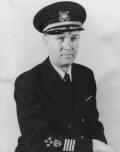 |
PNACO J. Webb L. Sheehy 1955 Deceased |
J. Webb L. Sheehy was born in Newcastle, Pennsylvania on April 5, 1905. After obtaining degrees from Cornell University, he settled in Rochester, New York where he was a practicing attorney for sixty years and town justice for thirteen. Sheehy was a charter member of the Coast Guard Auxiliary, joining as a Reserve member on December 11, 1939. Commanded by Lieutenant (j.g.) Sheehy, the eighty-two members of Flotilla 301 were active guarding Rochester's docks and waterfront facilities and performing many rescues during World War II. Sheehy's facility, Neaga, was a 40-foot 1913 cruiser which remained in service more than forty-five years. Sheehy was elected district commodore in 1954 from his position as rear commodore-east. He became national commodore in 1955.
Sheehy continued his Auxiliary membership throughout the course of his lifetime. In 1987, at age 82, he earned his coxswain qualification. He also continued his activities in the community, serving as a member of the Rochester Yacht Club, as commander of the Rochester Power Squadron, and president of the New York State Magistrates Association.
Sheehy died on August 26, 1992. He was survived by his wife, Ruth, one daughter and three grandchildren.
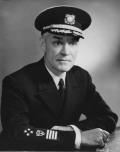 |
PNACO Alexander S. Bauer 1953-1954 Deceased |
Alexander “Pete” S. Bauer was born on May 22, 1903, in Philadelphia where he graduated from Central High School. He earned both undergraduate and law degrees from the University of Pennsylvania. As his life-time profession, he practiced law in Philadelphia and suburban counties. He and his wife, Isabel, and son lived in Wallingford.
For most of his life, Bauer was also a sailor. He was a member of the Sailing Club of the Chesapeake and Philadelphia’s fleet captain of the Corinthian club, a national association of sailors. During the late 1940s, he crewed in the Bermuda and Halifax yacht races.
As Bauer used to tell his son, having been born on May 22, 1903, he was too young for one war and too old for another. In 1941, when World War II broke out, Bauer had the choice of taking a desk job as a lawyer for the navy or joining the Coast Guard Auxiliary. Apparently believing he could use his sailing skills more usefully than his lawyering ones to help win the war, he chose the Auxiliary. He qualified as a coxswain and was first assigned to a schooner which monitored commercial traffic going in and out of the fish docks on the Delaware River and Bay areas.
On July 20, 1942, after regulations changed to allow enrollment in the Coast Guard Reserve on a part-time basis, Bauer signed up as a “TR” member of Flotilla 32, Ocean City, New Jersey, putting in the required 24 hours a week as a volunteer; he became qualified in piloting and navigation. Eventually he saw duty on two more vessels: a 65-foot fire and ice tug boat and Florence V, an 80-foot yacht, retrofitted with forward weapons and an underwater microphone used to pick up sounds of German submarines. Florence V served as the backbone of Bauer’s flotilla in the postwar years. The former wartime Auxiliarists established the Florence V Foundation, under which they apparently ran commercial charters and used the vessel to perform Auxiliary work as well (see further World War II recollections below).
Pete Bauer was disenrolled as a World War II temporary Reservist as of September 30, 1945, having successfully completed 1200 hours of active duty service as a qualified Chief Boatswain’s Mate. He reverted to Auxiliary status on July 23, 1945.
In 1952, Bauer was elected commodore of the 3rd Coast Guard District, Southern Area (now the 5th Northern). The year before Bert Pouncey had been elected as the first national commodore and the two worked closely together. In 1953, Bauer succeeded Pouncey during the time when the Auxiliary was being organized on a national basis, as were its cornerstone missions. Bauer wrote that their first mission was to convince the Coast Guard that the Auxiliary could assist them and they were not competing for Coast Guard officer status. Moreover, “We needed to smooth our relationship with the U. S. Power Squadron; we needed a full-time director in each District, a ‘raison d’être’, a treasury, a charter, and a Foundation, some way to stop the unauthorized wearing of the uniform of the C.[oast] G.[uard], an authorized text for the instructors (we wrote one), for our meetings and public courses. We almost had a riot at the Conference when they. . .heard we were to have ten cents National dues per year!”
During his tenure, Bauer continued the work he and Pouncey had begun, pushing for standardized programs and procedures and to unify the organization. He stressed that every member’s contributions were important and promoted better communications and public relations. The 8-lesson boating safety course text was introduced; the first public education registration fee of one dollar was charged students; Courtesy Marine Examinations (CMEs) were extended to Class A motorboats (16 ft. and under); the CME decal became recognized by other recreational boating organizations. Bauer initiated the publication of the first Auxiliary member, CME, and uniform manuals. District commodores worked with newly appointed Coast Guard District directors of Auxiliary and the first national treasurer was appointed. In 1953, the first national Auxiliary awards, the Plaque of Merit (A) and Certificate of Merit (B) were instituted.
In this organizing work, Bauer traveled widely across the United States and spent a considerable amount of time in Washington, conferring with the chief director of Auxiliary, Capt. Nat Fulford, with whom he became good friends. In fact, Fulford helped Bauer plump up his uniform, as he apparently decided he needed more awards to look like a national commodore. According to son Jon Bauer, “It was determined that once Dad had done fairly well at a handgun range so he was given the insignia of expert marksman. Additionally he received insignia for offshore patrol in a war zone. Dad found this humorous."
At the end of his term, Bauer was awarded the Certificate of Merit for his outstanding service in support of the Coast Guard Auxiliary by Cmdt. Alfred C. Richmond. His 1200 hours of active duty service earned him two 600-hour silver wrist tags, the World War II award whose qualifications made him eligible for the Victory and American Campaign Medals (it is not known if he applied for them). Commodore Bauer passed away on September 16, 1991, in his hometown of Wallingford, Pennsylvania, survived by his son.
![]()
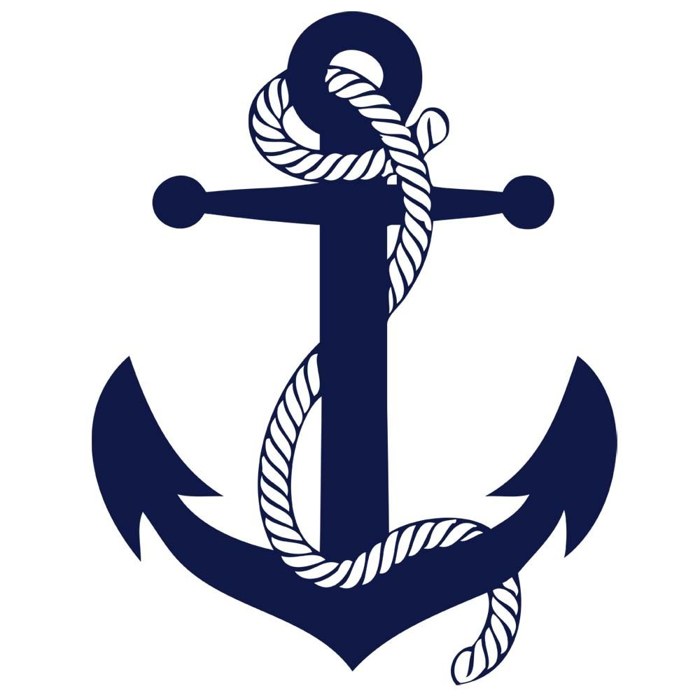 |
Recollections of PNACO Pete Bauer USCGR (T), 1942-45.* |
Adventures in Cruising the Delaware in Wartime:
From its inception in 1939, U. S. Coast Guard Auxiliary flotillas were formed in yacht clubs all up and down the East Coast. Within days following the outbreak of World War II on December 7, 1941, Germany declared war on the United States and Chancellor Adolf Hitler decided to send submarines to attack American shipping in home waters. Both the Navy and the Coast Guard were unprepared for this assault which decimated merchant shipping, resulting in the loss of thousands of seamen’s lives. Hence in June 1942, regulations were changed to authorize the enrollment of Auxiliarists on a part-time, temporary basis, with or without pay, for a one- to five month period** to meet the ongoing threat.
During these early days of the 2-ocean war, there were too few patrol boats and planes, convoys had not been instituted, U-boats easily targeted ships which were silhouetted against still brightly lit city skylines, and merchant captains often made the mistake of hugging the coastline. In June, German saboteurs landed off submarines on beaches on Long Island, New York and Florida.
By that date, however, Auxiliary patrols had proven their worth in the Florida Strait and the Gulf, having rescued scores of torpedoed crews and kept a sharp eye out for the Germans. Thus, a nationwide push got underway to enroll seaworthy 50- to 100+-foot sailboats and motor cruisers for antisubmarine work. Since Pearl Harbor the Auxiliary had virtually taken over harbor patrol work. In July 1942 in Philadelphia, the first Volunteer Port Security Force Unit was formed of volunteer men and women, all of whom did not possess seagoing backgrounds.
Alexander “Pete” Bauer was in his late thirties when the war broke out. In attempting to enroll in the Navy, he was able to perform their one required deep knee bend, but few more. Hence, he turned down a desk job to join the Coast Guard Auxiliary. On July 20, 1942, Bauer enrolled as a temporary Reservist, for the duration putting in the requisite 24 hours of active duty per week. As was the case nationwide, men from all walks of life enrolled to become wartime old salts: cab drivers, bus mechanics, short order cooks, salesmen, engineers, each applying his skills as a unit and crew member. Mariners’ seagoing backgrounds also varied: from recreational fishermen, to dinghy sailors and yachtsmen, to cabin and motor cruiser skippers. Bauer was a sailor, a member of Philadelphia sailing clubs. After he enrolled, he heard through his friends that the FBI had come around to inquire about his background. German spies and Nazi organizations were active in the East, even before the war broke out, and so someone entering the Coast Guard with a German name like Bauer needed to be vetted.
The Coast Guard next tested Bauer’s seamanship skills. Men going for coxswain were taken out in groups on the Delaware River to conduct boat maneuvering and docking exercises. According to son Jon Bauer, “I remember Dad saying that some potential skippers backed away from the wheel on their approach to the dock in the swift Delaware River current. He remembered his turn at the exercise approaching with the leeward screw engaged forward and the other in the neutral while the boat was abeam in the current.” Bauer passed his skipper check-offs and the first boat assigned him was a schooner; the second an ocean going tugboat equipped for fire fighting and ice breaking; and the third an 80-foot, first-class yacht loaned to the government by Bill McCann, named Florence V.
During the first months of the German U-boat assault, tensions ran so high that crews were sent out almost immediately upon sign up, often without proper uniforms. Apparently even after regulations were drafted, the uniforms may have been catch-as-catch can. In Bauer’s case, his wife made them for his crew. On one train ride to the dock, Bauer sat across the aisle from a Navy officer who kept eyeing him, obviously wondering who that was in what uniform.
Even though there was a war on, Philadelphians still sought out the beaches of the Stone Harbor, Wild Wood, and Cape May areas, riding the hundred miles or so by train to the shore. Both commercial and recreational fishing boats plied the waters. Some days Bauer’s crew would pick up clams for their own meals or hand them to fishermen and other patrol crews. However, their main job was to maintain a vigilant watch for U-boats and suspicious activities in the Delaware Bay and Atlantic in this important section of the intracoastal waterway. Again according to Jon Bauer, “Dockside [the TRs] would inventory each outgoing fishing boat so that a reasonable amount of provisions consumed could be documented on return. Fuel was measured. . . .It was important to be familiar with the personalities as well as the fishing boats and provisions.” This comment suggests that the CGR crews were on the lookout for fishermen who might be supplying the German U-boats with food and/or fuel. Early in the war, commercial fishermen were not pleased that the federal government was strictly regulating their operations. Arrests were made of persons selling fuel to U-boats.
Of course there were the funny, odd, and ludicrous events. Although Bauer knew the Delaware River well and piloted “by the seat of his pants,” this means of operation might not work out too well when less knowledgeable crew were on board. On one occasion, Bauer gave a heading to the helmsman of the day, only to emerge again just in time to blurt out, “but don’t hit the bridge.” Then there was the day the signalman was having the darnedest time figuring out a Morse code message being blipped from a ship docked at the Philadelphia Navy Yard. Unable to divine the “disjunct” garble, when they pulled alongside, they saw it was sparks being emitted by two welders that was the “code.” Apparently the cook on board possessed less than world-class culinary skills, particularly as concerned the morning bacon, even though he worked very hard and delivered meals promptly. Finally Bauer had to demonstrate that the large square of meat must be dissembled into strips in order to actually fry them, rather than just char the chunk.
When conducting offshore patrols, sailboats and seaworthy cruisers were assigned “grid” patrol areas along the 50-fathom curve of the Atlantic Coast. For this work, Bauer’s Florence V was painted battleship gray and fitted out with forward weaponry and an underwater microphone to pick up the sounds of the U-boats. “Some days the purpose was to drift quietly in the grid to listen and observe. At other times, it was to make engine disturbance to keep submarines consuming while submerged.” These tactics achieved two results. By drifting silently utilizing their microphones, the sailboats would be able to hear the U-boats which would not be able to hear them. The reverse reference to making engine disturbances points up the fact that U-boats would submerge upon approach of even the smallest vessel in fear of its location being reported to well-armed military craft and passing convoys; thus submerged in hiding, the submarines would needlessly consume fuel. Moreover, contrary to popular belief, German U-boats normally attacked on the surface at night, as they could only keep up with convoy speeds on the surface. So anything that kept the U-boats submerged would keep them from attacking, even small cabin cruisers and sailboats. The above tactical information further suggests that Florence V drifted to determine a U-boat presence, but turned on her engines if it was believed that U-boats were in the area, perhaps reported by other vessels or patrol planes.
Finally, one day the crew surely thought their day of reckoning had come. Unusual waves were seen to be caused by a metal “dark tower” in the water, possibly a submarine conning tower! The one rifle was produced from below. Alas, the “tower” turned out to be a harmless floating cylinder of some kind.
Bauer and crew also learned that sometimes “you just had to be there,” as the saying goes, to learn local conditions. On one patrol, the machinist mate reported that both engines were overheated. They finally figured out that they were passing a local distillery at the time of day (or night) when the company was disposing of its cooked sour mash by dumping it into the Delaware River.
* This short history has been adapted from son Jon Bauer’s 1992 written submission to the Coast Guard Auxiliary’s National Records Collection, Joyner Library, East Carolina University.
** Also see “Bravo Zero: The Coast Guard Auxiliary in World War II,” under text articles on this webpage for a full discussion of the Auxiliary and TRs during the war, particularly the Coastal Picket Force of sailboats and motor cruisers. N. B.: During the summer and fall of 1942, when the German threat was very high, crews were paid, although some took paid leaves from their jobs. In December 1942, regulations changed again: those who physically qualified could enroll in the active duty Reserves; otherwise, CGTRs could continue service only on a volunteer basis, or disenroll. – C. Kay Larson ![]()
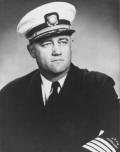 |
PNACO Bert C. Pouncey Jr. 1951-1952 Deceased |
Bert C. Pouncey, Jr., originally from Hughes, Arkansas, was elected the first national commodore of the U. S. Coast Guard Auxiliary in 1951. Pouncey had risen through the ranks to be elected commodore of the old 2nd District (8CR). Simultaneous to his election the National Board was established. He; Capt. Nat Fulford, chief director; and NAVCO Pete Bauer traveled the country to establish the Auxiliary as a national organization, working to standardize programs and initiating the first letters of instruction, manuals, forms, etc.
Under Pouncey's and Fulford's leadership, the notable AUXOP program was established in 1952, inspired by Boston flotillas which formed specially trained Operational Units that conducted exacting grid-pattern search drills with Civil Air Patrol planes, supervised by the Coast Guard. Other districts followed suit and the program got the attention of headquarters. Thus a formal program under which elite units, consisting of fifty members, five boats, two aircraft, and a radio station, were fielded in the districts. They would be specially trained by, and work closely with, regular units and called to duty in emergencies. Ultimately, however, the strict training and duty schedule proved difficult to maintain and often the combination of facilities could not be pulled together. As a result the program morphed into the current one in which the AUXOP award is earned by individual members who have passed specialty courses in seven areas, such as seamanship and search and rescue.
For his founding efforts and outstanding service, in 1953, Pouncey was awarded the Certificate of Merit (B) Award. In his professional life, Pouncey was a bank director. A member of the cotton exchange in Memphis, he lived on a large farm, renting to tenants. He owned two power boats that he operated on the Mississippi River.
He died suddenly on February 6, 1971, being survived by his Auxiliary family: wife, Dorothy, and two sons, all of Flotilla 81, Division 6, of Memphis, Tennessee.
![]()